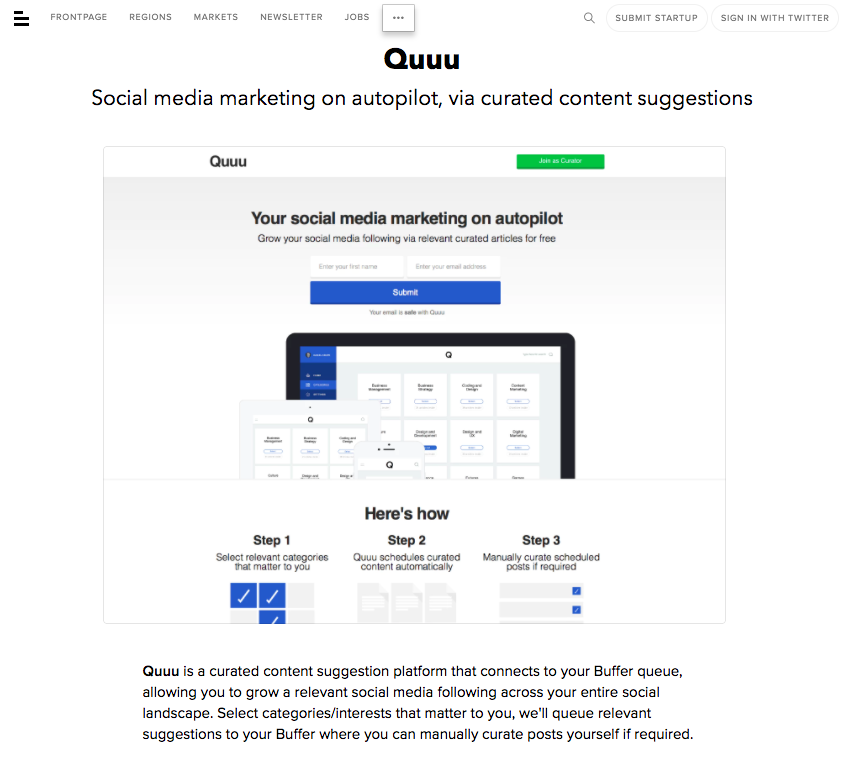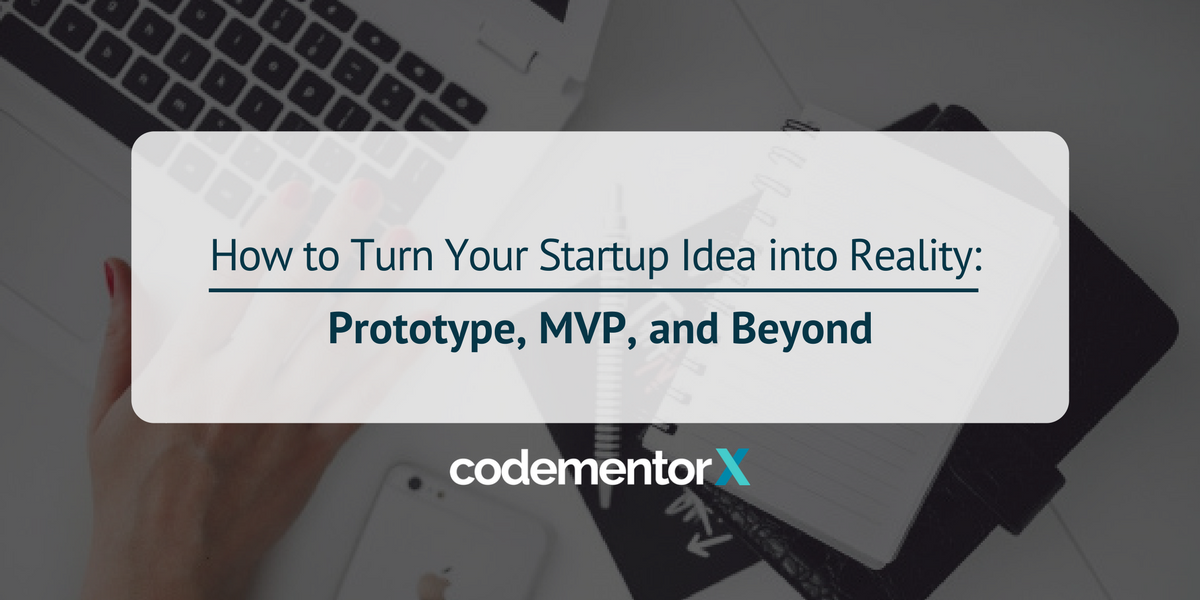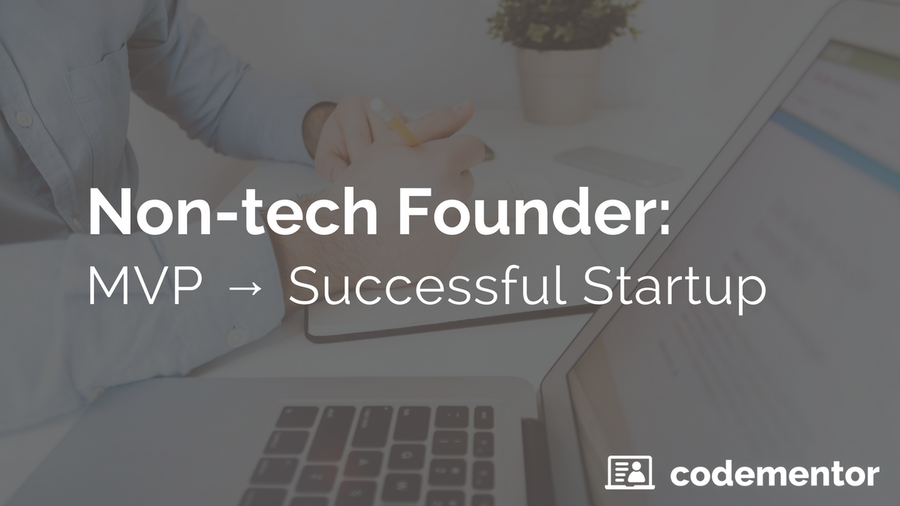In a world where we idolize founders who secure massive $10 million first-round investments, Mubashar "Mubs" Iqbal and Daniel Kempe took a markedly different approach.
Instead of going big, they went small.
In 2015, Mubs and Daniel launched Quuu — a content-suggestion platform that has grown to over 35,000 users in the last two years.
Shunning the traditional advice of working 80-hours a week while eating Ramen Noodles and sleeping on your friend’s couch to save money (until you get your $10 million seed round, anyway), Mubs and Daniel took an approach that almost looks humble in comparison.
They spent a weekend building something small.
Something with only the features necessary to launch it to the public — and nothing else.
They repeated the "go-small" approach when they went after funding — securing just £32,000 (~$40,000) in their initial round.
As you’ll see, it was plenty.
We sat down with Mubs and Daniel to ask them about their success.
Here are some of the lessons they learned as they built and launched Quuu, along with the big "ah-ha" takeaways we had while listening to their story.
We hope these stories and lessons from Quuu can also help you find a path to building a growing, successful app, without the "go big or go home" approach often normalized in startup circles.
Note: If you want to find a qualified remote developer to help you build your vision or website, you can do so on CodementorX.
Lesson 1: Going Smaller Means You Can Go Faster
Daniel had the initial idea for Quuu in early 2015.
At the time, Buffer had a service called "content suggestions," which provided suggested content inside the Buffer dashboard and via email.
Buffer’s team was hand-curating suggestions based on their own reading habits.
Daniel thought he saw a better way.
"I basically just took what Buffer was doing and expanded it," Daniel said. “I thought we could make some money with how the content was found.”
By "found," Daniel meant: “How the content is chosen for inclusion in the suggestions.”
His idea was to have content curated both by staff and by curators from the community he hoped to build (a.k.a. "Quuurators").
Eventually, he thought, they could monetize the platform by offering users the opportunity to submit content for inclusion in the tool’s suggestions — for a small fee.
Daniel is a designer but not a developer, so he pitched the idea to Mubs, a developer he knew from a Slack community run by Product Hunt.
Mubs liked the idea — with one qualification...
"It sounded like a lot of work," Mubs told us. “It was all fairly straightforward, but there were a lot of moving parts, and a lot of UI work to be done.”
For that reason, Mubs initially said he didn’t have time to work on the project.
And then, fate intervened.
Within weeks of Daniel and Mubs’ initial conversation, Buffer announced it would be shutting down its content suggestions feature.
That was July 10, 2015.
"Mubs got really excited about that," Daniel said. “That’s when he had the idea of just building our tool using the Buffer API.”
Stripping Features to Create an MVP
The decision to use Buffer’s API meant Daniel and Mubs could dramatically reduce the features for Quuu’s MVP.
Together, the two stripped away every unnecessary feature—culling it down to just the features necessary to launch it to the public.
"All we had to do was create a way for people to submit content for our library, plus a way for people to schedule it to their feeds," Mubs said.
With a much leaner idea for Quuu’s MVP, Mubs took some of Daniel’s visual concepts and built a working MVP the following weekend.
On July 20, 2015 — 10 days after Buffer announced it was closing down content suggestions — Quuu launched to the public on BetaList.
Within days, Daniel and Mubs had their first 300 users.
Takeaway: Because Quuu was stripped to only the features necessary for launch, it was built and released within days.
Lesson 2: You Don’t Need $10 Million in First-Round Funding
With a working product and 300 users, it was time to go looking for funding.
Why now?
Because demand for the product had been proven. The next step was to improve the product based on user feedback. To accelerate improvements and to grow the userbase, Daniel and Mubs needed to work on Quuu full-time for a while.
Here again, the co-founders took the "go small" approach.
They didn’t go after a massive first-round of funding, hoping to secure their financial futures for the rest of their lives.
Instead, they went after just enough funding to allow them to work on Quuu full-time.
A few months of runway. That’s all they were looking for.
Since neither of them were great at fundraising, they recruited Matthew Spurr to be their third co-founder.
With his help, the trio received an initial investment of £32,000 (~$42,000) investment from a source in the U.K. in October of 2015.
That £32,000 may not sound like much, but it bought them a critical six months to work on the product full-time.
"If you can afford to pay yourself so you can work on an idea full-time, it really accelerates the rate at which your product improves," Mubs told us.
"I think a lot of people skip out on that step because they want to raise that $5 million," he added. “But you’re never going to get to that point until you take the baby steps in the beginning to make the product better.”
Takeaway: Consider a small initial investment, which would allow you, like Quuu’s founders, to work full-time on your product.
The Power of Working on Your Idea Full Time
On November 3, 2015 — days after receiving their initial investment funding — the team launched Quuu on Product Hunt, where it quickly became the #1 Product of the Day.
1,100 new users signed up.
"It was a very successful launch," Daniel told us.
With an improved product and well over a thousand users, the team was in position to seek a bigger round of funding to continue their work on the project.
Five months after their initial investment, the team pitched a room of 100 investors, seeking an additional £120,000 of funding.
Within minutes of their presentation, they had what they were looking for.
"We smashed it," Daniel said. “A guy came over to us right after and told us he wanted to provide the entire amount.”
Takeaway: Don’t worry, a small round of funding can lead to bigger rounds of funding later on. But more importantly, it helps you effectively spend the time needed to validate your idea.
Monetizing the Product
Today, Quuu has over 35,000 users and a consistent revenue stream from its Quuu Promote product, which charges a small fee for content creators to include their content in Quuu’s suggestions.
It’s the same monetization feature Daniel pitched to Mubs two years ago.
In fact, it’s one of the key reasons Mubs said "yes" to Daniel in the first place — because he had a clear vision for how they could monetize the product down the road.
"Monetization doesn’t have to happen right away," Mubs told us. “But knowing that three or six months from now, this is how we’re going to make money—that’s really important and something a lot of people don’t think about.”
Instead, founders assume that "once they reach a certain number of users," revenue will magically begin arriving in their bank account.
"It never works out if they don’t have a clear monetization idea going in," Mubs said.
Takeaway: Have a monetization strategy in mind from the start, even if you’re not going to launch it right away.
A Different Approach to Building a Product
One weekend of work.
A small launch on BetaList.
First-round funding of £32,000.
At no time were Daniel or Mubs working 80 hours a week. Nor were they pressured to deliver fast results from a series of major investors.
Instead of going big, they went small.
For Mubs — the 2016 Product Hunt Marketer of the Year — it’s the only way to approach this process.
"I always try to find the fastest possible way to get to market," Mubs told us. “That’s how you get users to start telling you what features they really want. And that’s how you find success.”
Note: If you want to find a qualified remote developer to help you build your vision or website, you can do so on CodementorX.




